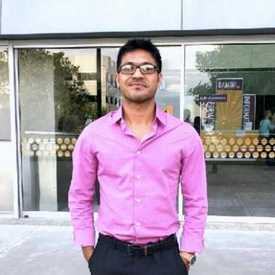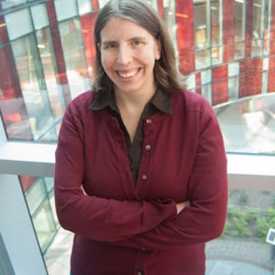Leaning into Lidar
September 16, 2024
Swarnav Banik (Credit: Swarnav Banik)
This story was originally posted by the UMD College of Computer, Mathematical, and Natural Sciences and has been reposted here with permission.
Swarnav Banik’s (Ph.D. ’21, physics) parents were visiting from India when they saw a strange-looking car on a San Francisco street that stopped them in their tracks.
“They asked what it was, and I said, ‘That’s a Waymo car. It has no driver in it. It drives itself.’ And they were so surprised,” Banik recalled. “They kept looking at the Waymo and taking pictures of it, they were so excited. And I said, ‘Yes, this technology is indeed exciting. Until a few years ago, we used to think of this as some future technology—now this is what I do.”
And what Banik does might just be the future of transportation. Since 2022, he’s been working on sensing technology for the next generation of autonomous vehicles. He first worked as a senior photonics engineer at Aurora Innovation, a company that’s developing self-driving systems for semitrucks and other commercial vehicles; now he’s at Aeva, a Silicon Valley firm developing sensing and perception tools for driverless cars and industrial automation.
In his work, Banik develops next-generation sensors that use lidar—light detection and ranging —technology to help autonomous vehicles “see” objects on the road ahead and safely avoid them.
“A typical autonomous vehicle has three kinds of sensors—a radar, a camera and a lidar,” Banik explained. “I have been working on frequency-modulated continuous wave lidar (FMCW), which has several advantages over the more commonly used time-of-flight lidar. Unlike time-of-flight lidars, FMCW lidar detects both the position and velocity of obstacles. This is extremely useful for highway driving where maneuvering decisions need to be made quickly.”
For Banik, working with lidar technology means putting his physics skill set to work in a way he never expected.
“Lidar is an interesting application of lasers. It uses many of the optical spectroscopy principles that I used as an atomic physics grad student, but I never thought I’d be doing anything like this,” he reflected. “It just kind of happened and I’m happy about it. I really like what I’m doing.”
The path to physics
Growing up in Mumbai, India, Banik was a curious and enthusiastic student, especially when he started taking high school physics.
“I really loved physics. It felt very logical, and I had a lot of fun solving physics problems,” he said. “In a way, it was like applying mathematics to real-world problems, and I believe that’s what interested me.”
In 2009, Banik entered the Indian Institute of Technology Delhi as an engineering physics major. As a sophomore, he landed an internship developing mathematical models for a cosmic ray experiment at the Tata Institute of Fundamental Research in Mumbai. Then as a junior, he interned in the U.S. at Fermilab, near Chicago, where he tackled the challenges of avalanche silicon photodiodes that are used for detecting high-energy particles.
“The idea was that these photodiodes would eventually be used in the Large Hadron Collider particle accelerator, and I was involved in the development of the photodiodes,” Banik explained. “I wasn’t married to particle physics back then, but I enjoyed designing engineering solutions from first principles: I learned how to break complex problems into smaller pieces and tackle them one by one, and I really appreciated that.”
After earning his undergraduate degree in India in 2013, Banik headed back to the U.S. to begin graduate school at the University of Maryland, where he hoped to find his niche in physics.
The thrill of research
“The Department of Physics at Maryland does very good research in almost every possible field of physics,” Banik explained. “I thought it would be a great place to get exposure and decide what I want to do.”
Banik connected with as many grad students and faculty members as he could, exploring everything from plasma physics and condensed matter theory to atomic, molecular, and optical physics and quantum information. Atomic physics won him over.
“The quantum computing applications that come out of atomic physics experiments were very exciting to me,” he recalled. “I saw grad students building atomic physics labs and I saw all the skills they had developed just by doing this research. I was impressed, and I wanted to be one of them.”
Working in UMD’s Joint Quantum Institute (JQI), Banik’s Ph.D. research focused on simulating cosmological inflation, such as the expansion of the universe, using a Bose-Einstein condensate.
"We start with sodium atoms and cool them to ultra-low temperatures of less than 100 nanokelvin using techniques like laser and evaporative cooling," Banik explained. "These atoms then form a quantum degenerate gas known as a Bose-Einstein condensate, and we use this as a platform to simulate phenomena like cosmological Hubble friction, which is impossible to study experimentally due to the massive scale of the universe."
For Banik, the thrill of successfully simulating Hubble friction—and working in the collaborative culture of JQI—energized and inspired him.
“I was working with Gretchen Campbell and Ian Spielman and they were really great,” he said. “The whole JQI ecosystem is so supportive. There are so many people you can rely on—the professors, the older grad students, the postdocs, we were constantly exchanging equipment and ideas.”
Lidar on a chip
After earning his Ph.D. in 2021, Banik charted a course toward industry. And he saw a unique opportunity at Aurora.
“Aurora makes autonomous freight-hauling trucks, and they were looking for someone with a physics mindset, someone who would approach solving problems from first principles,” Banik said. “Most of the people there were electrical engineers, and they needed someone who could think about next-gen architecture because they were building a newer version of the lidar sensor for fleets of vehicles.”
Over the next two years, Banik and his colleagues met that challenge, developing and patenting a cost-saving, integrated, chip-based lidar sensor system.
“Making a lidar sensor is not that tricky—but the company wanted to mass-produce them,” Banik explained. “These chip-based sensors have the same capability as the traditional bulk optic sensors, but they could be produced more cheaply and in volume, meaning more lidars for more trucks.”
When Banik took a test ride in an autonomous semitruck equipped with lidar and other sensors (and a human “operator” on board as a backup), he got a whole new perspective on what driverless technology could do.
“It was fascinating—I was in this big self-driving truck, not a simulation, this was the real thing,” he recalled. “It was highway driving, there was heavy traffic, and the operator wasn’t doing anything. He was just sitting there while the truck drove itself. And then when we weren’t on the highway, there was a pedestrian who came all of a sudden, and the truck stopped for the pedestrian—just like that. The truck did exactly what it was supposed to do.”
Earlier this year, Banik moved on from Aurora to become a senior photonics module engineer at Aeva, where he continues to work with lidar and sensing modules, advancing autonomous driving technology that could be on the road in the not-too-distant future.
“I feel that, if not today, then in a few years this technology is pretty much within the reach of the companies that are trying to do it,” Banik explained. “Aurora will be launching its self-driving trucks commercially by the end of this year, and I know of some other companies that are also doing that at the end of this year or early next year.”
There are still plenty of challenges on the road ahead, but Banik wouldn’t want to be anywhere else.
“It feels very good to be making an impact,” Banik said. “That’s the thing that motivates you and keeps you going. It’s pretty exciting.”
Experts
People
![Profile photo of Swarnav Banik]()
![Photo of Gretchen Campbell]()
Gretchen Campbell
Associate Vice President for Quantum Research and Education
Groups
JQI

